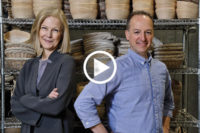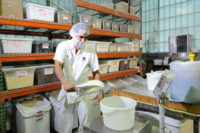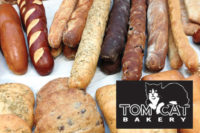
By Dan Malovany
Sooner or later, every company seems to have that defining moment. For some, it’s the decision to sell - or not sell - the business. For Jim Skinner, it came about three years ago when Audie Keaton, his vice president, walked into his office to present the company’s business plan for the next 12 months before something - or rather nothing - happened.
“Then, there was just … silence,” Skinner recalls.
For more than two decades, the Omaha, Neb.-based company had quietly developed a reputation in the retail trade for producing and co-packing high-quality, thaw-and-sell Danish, muffins, coffeecakes and other Old World sweet goods. Each year, in fact, the James Skinner Baking Co. produces more than 200 million products that are co-packed primarily for supermarket in-store bakeries, as well as for foodservice operators or to be sold under the brands of some of the largest food companies in the industry.
On that day, however, Skinner had a different idea.
“Here’s what I want to do,” he finally said. “I want to build a brand. I’m tired of talking about it.”
And guess what? The proverbial ball started to roll the company in a new direction. That sort of thing happens when the business has your name on it.
For Skinner, the timing just seemed right for the company.
“I see it as a natural evolution,” Skinner says. “It should have happened eight or 10 years ago, but it didn’t happen for a lot of reasons.”
No brand recognition - or even a brand name, for that matter - was one reason. Although well known as a respected contract manufacturer by many players in the food industry, everyday consumers had no idea who the company was or that they had been snacking on the bakery’s home-style products for years, says Keaton, who has spearheaded the initiative, which included not only building a brand but organization as well. (See article titled “Foundation for the Future” on page 15 of the April 2010 digital edition for more information.)
“For years, we have produced product for everyone else, and they get credit for what we do,” he says. “As a company, we felt it it’s time that we stand up on our own two feet, take the training wheels off and go out there and establish a brand. Are we starting from ground zero with establishing a brand? Yes, we are.”
Developing a brand is a daunting challenge for any company in the highly competitive food and consumer packaged goods industry. In some cases, it can take millions of dollars in media and promotional spending to establish a national presence in the market.
However, the James Skinner Baking Co. created a more affordable branding strategy that would allow it to compete within the big leagues, albeit within its means.
Primarily, instead of competing in the bread, sweet goods or other supermarket aisles in the heart of the stores, the company decided to target the in-store bakery channel. That’s right in its wheelhouse where it currently has a strong presence as a private label producer and where there is little, if any, competition from other brands.
Overall, Keaton notes, the goal is not to replace any private label products, but to provide a layer of additional, value-added, branded Danish and other sweet goods to drive traffic through the in-store bakery. As a result, the company avoids competing directly in the in-store bakery/deli channel. In fact, its current and potential customers could choose between keeping their existing private label program or take the option to upgrade to a new premium branded one that can potentially generate higher sales.
That’s a message that initially received a positive reception in the bakery’s preliminary talks with its existing base.
“Several of our [in-store bakery] buyers told us, ‘You need to brand your product, you should do so because of your quality,’” Keaton notes. “We have consistently showed that purchasing our products and putting [them] in an in-store bakery increases sales.”
Some Old-fashioned Sizzle
The company’s next challenge involved creating a new brand that would blow the doors off the way consumers typically perceived Danish and other home-style sweet goods.
“Our problem is taking something that is old-fashioned and traditional, that is established, that some people might consider boring and make it exciting and relevant for today’s consumers,” Keaton says.
Demographically, Danish and coffeecakes always have been popular with the 50 years and older crowd, but the company’s research showed another group - specifically younger males and middle-aged females - had been introduced to these timeless favorites over the last few years, partly through the explosion of cafes and coffeehouses, says David Skinner, Jim’s son and the company’s marketing manager.
Additionally, he notes, there was some bonus news. The data indicated that Danish and similar types of sweet goods have a strong following among Latino consumers.
“We’re sitting with a product that specifically seems to cater to the 50-plus category just because they grew up eating this type of product and know its quality, but you see the younger generation now look a little deeper into other products, and that’s where we have to come in with a more education type of process for them,” he says. “They don’t know the difference between a competitor’s product and our product sitting on the shelf next to one another.”
That’s where the new marketing plan came in. Working with an outside marketing firm, the family-run business, which has been involved in the baking and food industry for nearly 100 years, wanted to maintain its heritage, but present it to consumers in a youthful and contemporary way, notes Gary Kyle, vice president of sales and marketing who joined the company last year to spearhead the development and the execution of the bakery’s branded effort.
“It’s a great product with great quality and consumers love it, but it needed some sizzle,” Kyle says.
To shatter its products’ old-fashioned stereotype, the bakery settled on the more modern-soundingJ. Skinnername as its brand. In advertising and promotion materials, the new brand name is followed by the tagline of “modern artisan baking” that blends the old with the new.
Besides, the company wondered, if it has worked for artisan breads, why can’t it work for artisan sweet goods?
“We’re just doing what artisan bread bakers started doing years ago,” Kyle notes.
To create that complementary artisan appeal, the brand’s packaging, in-store displays, sales kits, trade pieces, consumer advertising, airport signage, billboards and even its newly designed Web site will feature an almost loft-like, weathered logo punctuated with a post-modernisticJ. Skinner name in all lower-case, scripted lettering.
“We just loved this sort of Picasso signature of Jim’s,” Kyle says.
The company and its agency then explored all avenues of “voices” for the brand ranging from a turn-of-the-century nostalgia and leveraging the business’ Midwestern roots to the bistro contemporary look that it settled on along with a touch of feminine chic, Kyle explains.
“We looked at James Skinner Baking Co., The James Skinner Baking Co., and everybody loved it when it got to ‘J. Skinner….modern artisan bakers,’” Kyle recalls. “We wanted to show the products because they photographed so well. We wanted to show the sizzle. On an outdoor board, we want to show the product upfront, close and personal, that you understand that the texture comes from 108 layers of Danish. We also want to show people enjoying it and that it’s a treat.”
More often than not, Keaton adds, Danish and other sweet good products typically sold in in-store bakeries are displayed in what can seem like a “vast sea of plastic.” All too often, they get lost in the omnipresent displays of clamshells and other similar-looking packages.
To differentiate the look of products from the rest, Kyle adds, the new J. Skinner packaging will have die-cut cardboard sleeves that feature its signature logo and a beauty shot of the product against a warm, brown background.
In addition to capturing the essence of hearth-based goodness, Keaton notes, the sleeve is designed to show more of the product itself in the plastic, tamper-proof trays.
“The products are strong visually, and they’re great to eat, which is most important,” he says. “It satisfies you, and it’s filling in every bite.”
To execute its marketing strategy, which makes its debut at the International Dairy-Deli-Bakery Association show in June in Houston, the company will cloak its bistro brand around traditional baking with a contemporary message.
Airport signage, for instance, features a young girl with a glamour shot of a decadent cinnamon bun carried under the “CINFULL” message. Likewise, a consumer ad suggests, “‘Stressed’ spelled backwards is ‘desserts.’ Coincidence? We think not.”
“It’s fun, it’s a treat, it’s an indulgence, it’s enjoyable, and we’re going to do just that,” Kyle says. “We’re going to have fun with the brand.”
The company’s fundamental message? “You know you want to,” as the campaign says. Giving into a little bit of innocent temptation every once and a while isn’t going to hurt you.
“It’s the indulgence idea,” Kyle says. “Yeah, people know it’s an indulgent category, and they have been watching their weight forever, but it’s such a great product that you buy it for that reason.”
That’s the same message the bakery is giving younger consumers. According to the company’s market research, they tend to be label readers that check the calorie counts and the ingredients legend to make sure the product contains wholesome ingredients that are good for them, David Skinner adds.
“Our product is indulgent, but at times, you have to let it go,” he says. “You just can’t eat grains and lean meat all of the time.”
Portion control, especially smaller, individual sizes of indulgent products, is a perfect way to achieve a balance of the best of both worlds, David Skinner says. Down the line, the company plans to explore that avenue - including adding time-tested nutritional building blocks such as whole grains to its products - to further broaden the reach of its new brand.
At the same time, the company can’t forget what type of product it’s producing.
“Strip Danish isn’t exactly synonymous with health food,” he says.
True to the Core
Today, the primary focus remains on sticking to the core values that built the family business in the first place while creating a brand that enhances the value of the company for everyone involved.
“With the whole branding initiative, we’re going to reinvent the in-store bakery,” Keaton explains. “We’re going to create high-impact displays to introduce people to J. Skinner. To be honest, you get our product in a consumer’s mouth and they love it. Our customers will come to expect quality when they choose J. Skinner.”
The bakery relies on such traditional production methods as fermenting the dough overnight to fully develop its sweet flavor as well as creating layers of laminated Danish with as many as 108 folds to ensure a soft texture.
That’s because some things like quality Danish and wholesome sweet goods never go out of style. In fact, the company then empowered its veteran bakers to ratchet up its branded products to take them to the next level in terms of taste, texture and appearance.
“We told our bakers who have been producing these products for 25 years to be creative and give us their best. We wanted them to develop a collection of Danish and muffins that they would be proud of. As true craftsmen, we knew they would develop the best line in the business,” Keaton says.
The company wanted to make products like “mom use to make,” he adds.
“Our intention is not to sell a product one time, but our expectation is that consumers will come back time and time, again, to purchase that same product,” Keaton says. “That’s the secret to our longevity and that’s how we want to move forward.”
With the new branding initiative, Kyle says, the key is a defined strategy going forward with flawless execution.
Keaton, likewise, feels the bakery is on the verge of something big. As a family-owned company, Skinner Baking can invest to sustain quality. It doesn’t have to cut costs to meet margins for quarterly earnings. Even in today’s economy, the company can afford to be aggressive in the market.
“We’re a privately held company that’s true to its mission,” he says. “We know our objective is true. We know the process that we’re going through to accomplish our goals is sound, and that it’s matter of execution. We’re comfortable with who we are. We’re comfortable in our own skin, and we know exactly how to proceed over the next five to seven years.”
For Jim Skinner, who’s been in food business with his family since he was a child, it’s an exciting time.
“We’re in a nice transition period,” he says. “We’re not doing widgets or the same old, same old, and it’s not boring. It’s fun, it’s a challenge, and we’ve been invigorated.”
Still, he has an eye on something else. He pauses, and there is a moment of silence.
“The future - one that is fulfilled and the brand is in place - would entail an acquisition, and it might be back to one of my original ideas for the company and that would be in bread,” he says. “A high-end bread company. Do you know of any names that we can contact?”
He just wants to take this modern artisan bakery in a new direction.



